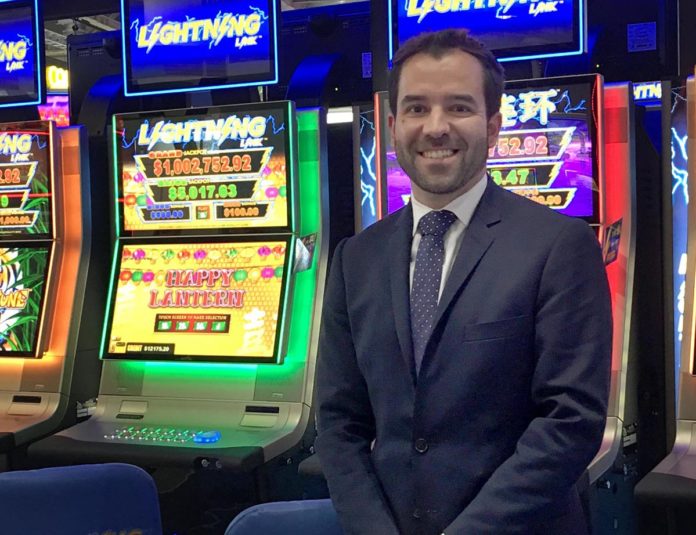After a very strong fiscal year in 2016, the public and shareholders are eagerly awaiting Aristocrat’s first half-year results. Business Daily sat down with Ben Attwood, Senior Manager of Product Strategy and Planning for Australia and Asia Pacific, to get a feel for what the group is looking forward to and its philosophy on creating.
After such a strong fiscal 2016, is there any worry about the company getting too big?
The company has expanded quite significantly in the last five years, but we’ve got a great leadership team in terms of our CEO Trevor Croker, who has been in the business for over eight years. We’ve got a great executive team too. The actual structure that they’ve set up, I think we’re well positioned, with dedicated teams for each of the business units. Part of my role is the ANZ (Australia, New Zealand) and Asia Pacific product strategy, but each of the seven businesses across Aristocrat are very well structured.
Within the company’s fiscal 2016 results it noted that it’s looking for ‘organic and inorganic opportunities to accelerate growth’. How exactly?
The inorganic will be 2020 and beyond, organic is what we do now – and that can be initiatives and strategies to take share in a particular market or to improve our product performance. So it could be efficiencies, but also could be improving in segments where we are not the leader – we’re not the leader in every segment. So there’s a lot of potential in terms of us doing things a bit better, and obviously how our competitors are performing quite strongly.
Profit was up 70 per cent. Are there any main obvious factors that may have driven that?
People and product is everything. I think culture has been a big thing, having the right people. But we’ve been very fortunate to have a number of very talented studios throughout the company, some great creative people. So people and product has been key.
How do you see Macau’s contribution to last year’s results, and how is it contributing to this fiscal year so far?
It’s hard to say the exact numbers, but Asia Pacific has always been a flagship market for Aristocrat in terms of – it’s well known in other markets our position here – and it does play a part, but a lot of our revenue is in the U.S. and Australia. So although important, it’s been consistent and we have to just maintain our market share over the next twelve months to two years. Obviously casino openings play a big part in that fluctuation, so the challenge now will be how we maintain our position and product strategies to stay ahead.
Given the speed and frequency of the recent casino openings over the past decade in Macau, does the slowdown in openings make your workload easier?
Within the limited operators in Asia Pacific, it’s obviously a typically existing company. We have a relationship with those operators and being already in the market and knowing our position, that’s helped us in gaining share in these new openings.
Within the digital area, your last fiscal year saw revenue grow 80 per cent, but profit grew 127 per cent. How much of that was happening in the Asia Pacific area?
A smaller percentage [than the main markets]. We have the FaFaFa application across Asia Pacific and Heart of Vegas, which is our main one for Australia and the U.S.
How does Facebook fit in?
You can play the same version online, or on iOS or Android you can get it on Facebook. We are seeing some crossover of the land based player and the digital player.
Will there have to be millennial oriented products?
I think watching some of our competitors experiment in terms of skill-based [games] and other crossover to online products, I think there will be a time. What that is, it is hard to say. It’s such a wide choice in terms of forms of entertainment, it’s very, very difficult, very hard to say.
We’re trying to build up our player base, and in every market and every jurisdiction it differs in some way, relating to age group. We’re gathering feedback from our operators. They’re often our best insight into player behaviour. So we seek a lot of guidance from the operators.
Research and development went up 25 per cent in annual terms last fiscal year. Do you think that’s necessary to maintain the increase in funding consistently?
It’s hard for me to say what the makeup of that is. We do have product watchers, typically as R&D investment, but typically we retain talent. As our business expands and to stay ahead we need to continue to fund and innovate; product is the key and we got the people [to make it happen].
Some gaming manufacturers have said that up to 90 per cent of ideas get left on the research and development cutting room floor. Is that accurate for Aristocrat?
I wouldn’t say it’s that high for our business, because definitely a lot of concepts that our creative teams put forward, not all of them see the light of day. But it’s the ones that are commissioned, that do go ahead, that have numerous, numerous reviews and innovations. So our creative teams take a lot of pride, because for them it’s very important to try and make the best product.
The new Lightning Link unit that the company has introduced seems to be one of its star new products. Can you describe the release schedule?
Lightning Link has been released in the last two months across Asia. It’s been in the Philippines, in Malaysia, in Vietnam, and in Macau has just gone into two venues. So early days, it’s only been in for a few weeks but Lightning Link has been the number one product in the last few years. Asia Pacific was the last region to receive it, so we’re optimistic.
For that product in particular [we released in] Australia first two years ago, then to the U.S. and then last to Asia. It just depends on the development studio to see which region or market to hit first, but our team’s very excited and our customers as well.
How long do you need to gather data on customer play?
Typically, we like to say, a minimum of three months you get a great feel. And that’s when you choose whether the product will either stay on the floor or an alternative. So you’ve got three months typically – player acceptance, technical interface, is very important.
How does the arrangement work to place the machine at the venue? Do you do any profit split?
We don’t do any profit split across Asia Pacific. We do have lease models, so depending on the product, it’s available. Typically it’s just a straight out sale and then we have a warranty period, and if a particular game doesn’t perform to a certain level we have a catalogue of games and we can convert that game. So for example, I bought a new cabinet and it has to perform up to a certain level. If it’s below performance expectation, then we can convert the game.
How much effort are you putting into Japan, and do you need to be focusing on it now or wait until the operators are installed?
We have a team that’s been up to Japan for the gaming congress, so we’re staying very close to developments there. You do have to start preparing, you do have to take all the steps right now, so we have a team that’s assigned to that.
Where else are you guys looking to expand operations to handle ongoing demand?
Macau’s still our head office in Asia Pacific, and the Philippines is going to be a big focus – the new openings that are going to be happening around Marina Bay over the next two years. The Philippines is bound to be a large gaming offer, so we’d expect to see a bit of growth in that market. And then we’ll see what happens in Singapore. There are other markets to kind of follow the Philippines, but the Philippines will definitely be the big one looking forward.
Has the uncertainty around the legal environment had any effect on your operations in the Philippines?
We’ve got local teams who’re based there, again, having relationships with the operators and getting the information first-hand, but I don’t think that it’s had any impact on the operations.
Given the uncertainty, a lot of companies are shifting out to Vietnam, Cambodia and Laos. Are those attractive markets for you given that they’re not so large yet?
Every customer is important. We have account managers dedicated to the Philippines, we have account managers dedicated to Malaysia and Cambodia, so we’re in touch with operators in most of the region and have seen a lot of growth, particularly from Vietnam recently. I think Vietnam has been a good market for us. We’ve got a great position and we’re dealing with a number of the smaller operators and I think it’s going to be an important market for us.
Are you excited about the potential for local gaming happening there?
I haven’t heard too much about exactly when that’s happening. I have heard it’s been talked about.
On the digital side, you saw daily average users hit 1.2 million during the last fiscal year, 16 per cent growth year-on-year. What does that mean for the next fiscal year?
Digital’s mostly managed out of the U.S. It’s not a large part of our business here.
Does being the market leader in Australia bring any challenges?
You’ve got to be more creative because you have to support a bigger base. There’s very strong competition in Australia, with Scientific Games, IGT, so we’ve always been the leader, but we lost a bit of the leading position for a while. So we remain focused on retaining our footprint and pushing growth.
Some of the other competition around you has grown through mergers and acquisitions. How does that keep you on your toes?
There are some big companies that have come together and you can understand that they’ve got great creative, and bringing their creative talent they’re going to have a lot more efficiency, so no doubt they will have to get through all the hurdles, but we’re always watching out.
























